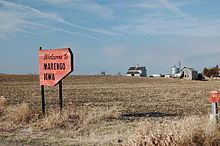FIPS code 19-49395 Elevation 225 m Population 2,513 (2013) Area code 642 (319 Exchange) | Time zone Central (CST) (UTC-6) GNIS feature ID 0458801 Zip code 52301 Local time Tuesday 1:15 AM | |
 | ||
Weather 8°C, Wind N at 16 km/h, 59% Humidity Area 5.543 km² (5.387 km² Land / 16 ha Water) | ||
Marengo is a town in and the county seat of Iowa County, Iowa, United States. It has served as the county seat since August 1845, even though it was not incorporated until July 1859. The population was 2,528 in the 2010 census, a decline from 2,535 in 2000.
Contents
- Map of Marengo IA 52301 USA
- History
- Geography
- 2010 census
- 2000 census
- Library
- Education
- Notable people
- References
Map of Marengo, IA 52301, USA
History
Marengo was laid out in 1845 and platted in 1847. The city's name commemorates the Battle of Marengo, where Napoleon defeated the Austrian army.
Geography
According to the United States Census Bureau, the city has a total area of 2.14 square miles (5.54 km2), of which 2.08 square miles (5.39 km2) is land and 0.06 square miles (0.16 km2) is water.
The Iowa River passes north of town.
2010 census
As of the census of 2010, there were 2,528 people, 1,059 households, and 648 families residing in the city. The population density was 1,215.4 inhabitants per square mile (469.3/km2). There were 1,154 housing units at an average density of 554.8 per square mile (214.2/km2). The racial makeup of the city was 97.3% White, 0.6% African American, 0.6% Native American, 0.4% Asian, 0.4% from other races, and 0.7% from two or more races. Hispanic or Latino of any race were 2.8% of the population.
There were 1,059 households of which 30.5% had children under the age of 18 living with them, 45.2% were married couples living together, 10.3% had a female householder with no husband present, 5.7% had a male householder with no wife present, and 38.8% were non-families. 34.4% of all households were made up of individuals and 17.2% had someone living alone who was 65 years of age or older. The average household size was 2.31 and the average family size was 2.94.
The median age in the city was 41 years. 24.9% of residents were under the age of 18; 6.9% were between the ages of 18 and 24; 24% were from 25 to 44; 26.2% were from 45 to 64; and 18.1% were 65 years of age or older. The gender makeup of the city was 47.9% male and 52.1% female.
2000 census
As of the census of 2000, there were 2,535 people, 1,057 households, and 658 families residing in the city. The population density was 1,210.5 people per square mile (468.3/km²). There were 1,135 housing units at an average density of 542.0 per square mile (209.7/km²). The racial makeup of the city was 98.11% White, 0.28% African American, 0.04% Native American, 0.67% Asian, 0.28% from other races, and 0.63% from two or more races. Hispanic or Latino of any race were 1.14% of the population.
There were 1,057 households out of which 30.4% had children under the age of 18 living with them, 48.9% were married couples living together, 9.5% had a female householder with no husband present, and 37.7% were non-families. 32.9% of all households were made up of individuals and 16.5% had someone living alone who was 65 years of age or older. The average household size was 2.32 and the average family size was 2.98.
Age spread: 25.4% under the age of 18, 6.9% from 18 to 24, 27.5% from 25 to 44, 21.5% from 45 to 64, and 18.7% who were 65 years of age or older. The median age was 38 years. For every 100 females there were 88.9 males. For every 100 females age 18 and over, there were 85.5 males.
The median income for a household in the city was $36,509, and the median income for a family was $47,153. Males had a median income of $32,986 versus $21,401 for females. The per capita income for the city was $17,425. About 6.1% of families and 7.3% of the population were below the poverty line, including 6.5% of those under age 18 and 11.9% of those age 65 or over.
Library
The Marengo Public Library is a Carnegie library, constructed in 1904-1905, and Marengo is believed to be the smallest town in the United States to have received a donation from Andrew Carnegie for the construction of a library. The Library completed a renovation and addition in May 2007.
Education
Local public schools in Marengo include Iowa Valley Elementary School and Iowa Valley Junior Senior High School, part of the Iowa Valley Community Schools. The Iowa Valley Junior High and High School teams are the Tigers.
The Iowa Valley Tigers were the dominant 1985 State Champions in Track and Field for Class 2A, winning 45 points over the second place team's 31.50. This included Matt Zuber's Class 2A records in the long jump (24'-3") and the 110 meter high hurdles (14.1 sec).
